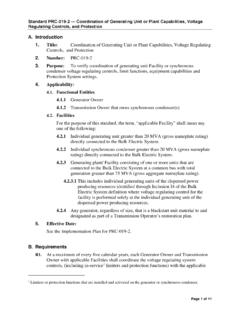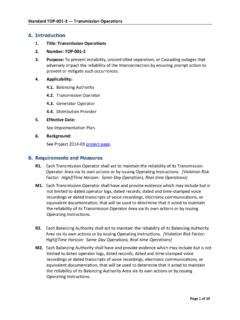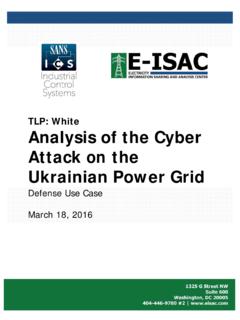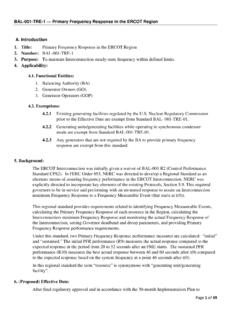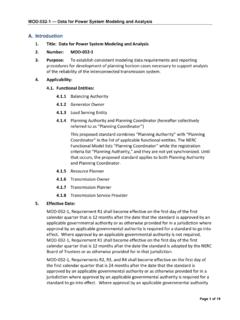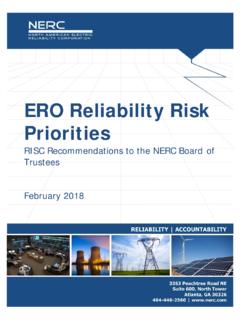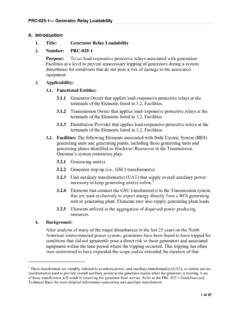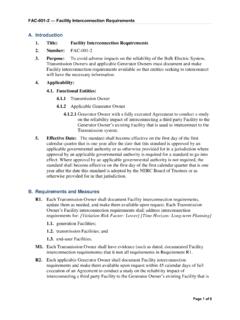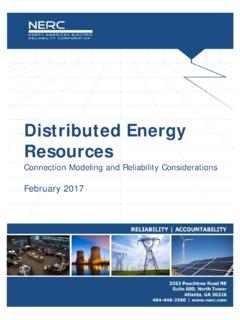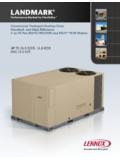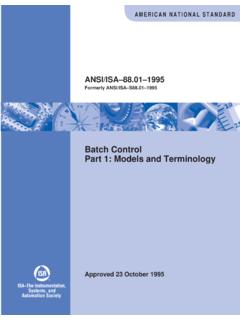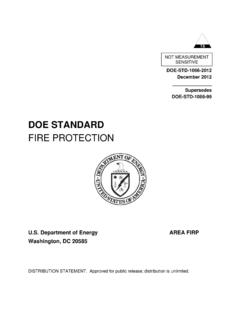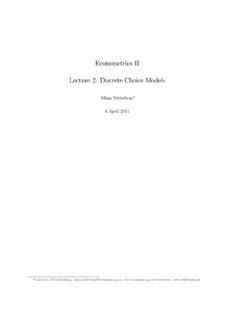Transcription of A. Introduction - NERC
1 Standard MOD-027-1 Verification of Models and Data for Turbine/Governor and Load Control or Active Power/Frequency Control Functions Page 1 of 16 A. Introduction 1. Title: Verification of Models and Data for Turbine/Governor and Load Control or Active Power/Frequency Control Functions 2. Number: MOD-027-1 3. Purpose: To verify that the turbine/governor and load control or active power/frequency control1 model and the model parameters, used in dynamic simulations that assess Bulk Electric System (BES) reliability, accurately represent generator unit real power response to system frequency variations. 4. Applicability: Functional entities Generator Owner Transmission Planner Facilities For the purpose of the requirements contained herein, Facilities that are directly connected to the Bulk Electric System (BES) will be collectively referred to as an applicable unit that meet the following: Generation in the Eastern or Quebec Interconnections with the following characteristics: Individual generating unit greater than 100 MVA (gross nameplate rating).
2 Individual generating plant consisting of multiple generating units that are directly connected at a common BES bus with total generation greater than 100 MVA (gross aggregate nameplate rating). Generation in the Western Interconnection with the following characteristics: Individual generating unit greater than 75 MVA (gross nameplate rating). Individual generating plant consisting of multiple generating units that are directly connected at a common BES bus with total generation greater than 75 MVA (gross aggregate nameplate rating). Generation in the ERCOT Interconnection with the following characteristics: 1 Turbine/governor and load control or active power/frequency control: a. Turbine/governor and load control applies to conventional synchronous generation. b. Active power/frequency control applies to inverter connected generators (often found at variable energy plants).
3 Standard MOD-027-1 Verification of Models and Data for Turbine/Governor and Load Control or Active Power/Frequency Control Functions Page 2 of 16 Individual generating unit greater than 50 MVA (gross nameplate rating). Individual generating plant consisting of multiple generating units that are directly connected at a common BES bus with total generation greater than 75 MVA (gross aggregate nameplate rating). 5. Effective Date: For Requirements R1, and R3 through R5, the first day of the first calendar quarter beyond the date that this standard is approved by applicable regulatory authorities or as otherwise made effective pursuant to the laws applicable to such ERO governmental authorities. In those jurisdictions where regulatory approval is not required, the standard shall become effective on the first day of the first calendar quarter beyond the date this standard is approved by the NERC Board of Trustees, or as otherwise made effective pursuant to the laws applicable to such ERO governmental authorities.
4 For Requirement R2, 30 percent of the entity s applicable unit gross MVA for each Interconnection on the first day of the first calendar quarter that is four years following applicable regulatory approval or as otherwise made effective pursuant to the laws applicable to such ERO governmental authorities, or in those jurisdictions where no regulatory approval is required, on the first day of the first calendar quarter that is four years following NERC Board of Trustees adoption or as otherwise made effective pursuant to the laws applicable to such ERO governmental authorities. For Requirement R2, 50 percent of the entity s applicable unit gross MVA for each Interconnection on first day of the first calendar quarter that is six years following applicable regulatory approval or as otherwise made effective pursuant to the laws applicable to such ERO governmental authorities, or in those jurisdictions where no regulatory approval is required, on the first day of the first calendar quarter that is six years following NERC Board of Trustees adoption or as otherwise made effective pursuant to the laws applicable to such ERO governmental authorities.
5 For Requirement R2, 100 percent of the entity s applicable unit gross MVA for each Interconnection on the first day of the first calendar quarter that is 10 years following applicable regulatory approval or as otherwise made effective pursuant to the laws applicable to such ERO governmental authorities, or in those jurisdictions where no regulatory approval is required, on the first day of the first calendar quarter that is 10 years following NERC Board of Trustees adoption or as otherwise made effective pursuant to the laws applicable to such ERO governmental authorities. Standard MOD-027-1 Verification of Models and Data for Turbine/Governor and Load Control or Active Power/Frequency Control Functions Page 3 of 16 B. Requirements R1. Each Transmission Planner shall provide the following requested information to the Generator Owner within 90 calendar days of receiving a written request: [Violation Risk Factor: Lower] [Time Horizon: Operations Planning] Instructions on how to obtain the list of turbine/governor and load control or active power/frequency control system models that are acceptable to the Transmission Planner for use in dynamic simulation, Instructions on how to obtain the dynamic turbine/governor and load control or active power/frequency control function model library block diagrams and/or data sheets for models that are acceptable to the Transmission Planner, or model data for any of the Generator Owner s existing applicable unit specific turbine/governor and load control or active power/frequency control system contained in the Transmission Planner s dynamic database from the current (in-use) models.
6 R2. Each Generator Owner shall provide, for each applicable unit, a verified turbine/governor and load control or active power/frequency control model , including documentation and data (as specified in Part ) to its Transmission Planner in accordance with the periodicity specified in MOD-027 Attachment 1. [Violation Risk Factor: Medium] [Time Horizon: Long-term Planning] Each applicable unit s model shall be verified by the Generator Owner using one or more models acceptable to the Transmission Planner. Verification for individual units rated less than 20 MVA (gross nameplate rating) in a generating plant (per Section , , or ) may be performed using either individual unit or aggregate unit model (s) or both. Each verification shall include the following: Documentation comparing the applicable unit s MW model response to the recorded MW response for either: A frequency excursion from a system disturbance that meets MOD-027 Attachment 1 Note 1 with the applicable unit on-line, A speed governor reference change with the applicable unit on-line, or A partial load rejection test,2 Type of governor and load control or active power control/frequency control3 equipment, 2 Differences between the control mode tested and the final simulation model must be identified, particularly when analyzing load rejection data.
7 Most controls change gains or have a set point runback which takes effect when the breaker opens. Load or set point controls will also not be in effect once the breaker opens. Some method of accounting for these differences must be presented if the final model is not validated from on-line data under the normal operating conditions under which the model is expected to apply. 3 Turbine/governor and load control or active power/frequency control: Standard MOD-027-1 Verification of Models and Data for Turbine/Governor and Load Control or Active Power/Frequency Control Functions Page 4 of 16 A description of the turbine ( for hydro turbine - Kaplan, Francis, or Pelton; for steam turbine - boiler type, normal fuel type, and turbine type; for gas turbine - the type and manufacturer; for variable energy plant - type and manufacturer), model structure and data for turbine/governor and load control or active power/frequency control, and Representation of the real power response effects of outer loop controls (such as operator set point controls, and load control but excluding AGC control) that would override the governor response (including blocked or nonfunctioning governors or modes of operation that limit Frequency Response), if applicable.
8 R3. Each Generator Owner shall provide a written response to its Transmission Planner within 90 calendar days of receiving one of the following items for an applicable unit. Written notification, from its Transmission Planner (in accordance with Requirement R5) that the turbine/governor and load control or active power/frequency control model is not usable, Written comments from its Transmission Planner identifying technical concerns with the verification documentation related to the turbine/governor and load control or active power/frequency control model , or Written comments and supporting evidence from its Transmission Planner indicating that the simulated turbine/governor and load control or active power/frequency control response did not approximate the recorded response for three or more transmission system events. The written response shall contain either the technical basis for maintaining the current model , the model changes, or a plan to perform model verification4 (in accordance with Requirement R2).
9 [Violation Risk Factor: Lower] [Time Horizon: Operations Planning] R4. Each Generator Owner shall provide revised model data or plans to perform model verification5 (in accordance with Requirement R2) for an applicable unit to its Transmission Planner within 180 calendar days of making changes to the turbine/governor and load control or active power/frequency control system that alter the equipment response characteristic6. [Violation Risk Factor: Lower] [Time Horizon: Operations Planning] a. Turbine/governor and load control applies to conventional synchronous generation. b. Active power/frequency control applies to inverter connected generators (often found at variable energy plants). 4 If verification is performed, the 10 year period as outlined in MOD-027 Attachment 1 is reset.
10 5 Ibid. 6 Control replacement or alteration including software alterations or plant digital control system addition or replacement, plant digital control system software alterations that alter droop, and/or dead band, and/or frequency response and/or a change in the frequency control mode (such as going from droop control to constant MW control, etc). Standard MOD-027-1 Verification of Models and Data for Turbine/Governor and Load Control or Active Power/Frequency Control Functions Page 5 of 16 R5. Each Transmission Planner shall provide a written response to the Generator Owner within 90 calendar days of receiving the turbine/governor and load control or active power/frequency control system verified model information in accordance with Requirement R2 that the model is usable (meets the criteria specified in Parts through ) or is not usable. The turbine/governor and load control or active power/frequency control function model initializes to compute modeling data without error, A no-disturbance simulation results in negligible transients, and For an otherwise stable simulation, a disturbance simulation results in the turbine/governor and load control or active power/frequency control model exhibiting positive damping.
